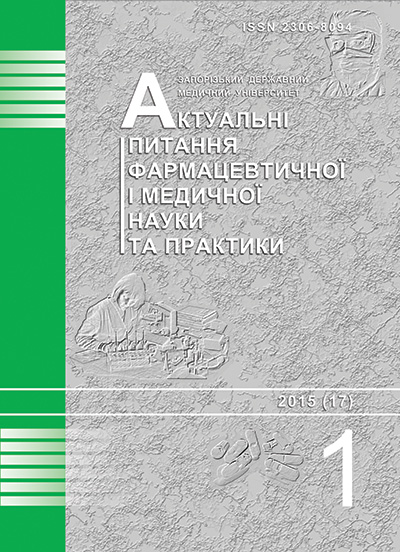PROPERTIES OF NEW SALTS OF 2-(5-(ADAMANTANE-1-YL)-4-R-1,2,4-TRIAZOLE-3-YLTIO)ACETIC ACIDS IN THE GLUCOSE TOLERANCE TEST
DOI:
https://doi.org/10.14739/2409-2932.2015.1.41207Keywords:
derivatives 1, 2, 4-triazole, glucose tolerance test, hyperglycemiaAbstract
The concentration of glucose in the blood is one of the integral indicators of the internal environment that reflects the metabolism of carbohydrates, proteins and fats in the body. Glucose is a key component of human metabolism. The level of blood sugar is one of the most important controlled constants of body that defines homeostasis and displays the status of carbohydrate metabolism. Low blood sugar (hypoglycemia) is a dangerous condition when blood glucose is critically low.
The aim of research. The aim of our study was pharmacological screening of the effects of the newly synthesized salts of 2-(5-adamantane-1-yl)-4-R-1,2,4-tirazol-3-yltio)acetic acids on glucose blood level in experimental animals.
Materials and methods. The compounds have been synthesized at the Department of Inorganic Chemistry and Toxicology of Zaporozhye State Medical University (the Head of the chair, Professor Panasenko O.I.). Blood glucose levels of saults of2-(5-adamantane-1-yl)-4-R-1,2,4-tirazol-3-yltio)acetic acids in rats have been evaluated by intraperitoneal glucose tolerance test (IGTT). IGTT was reproduced by glucose load on animals in a dose of 2 g / kg of rat’s body weight. White nonlinear rats weighing 160-230 g were involved in experiments. Animals were divided into 13 groups of 7 animals in each group: the 1st is intact one; the 2nd is control one with glycemia (untreated), the 3rd group of the animals received glibenclamide in the dose of 1 mg / kg; the groups 3-13 received 1,2,4-triazole derivatives. The compounds were dissolved in purified water at the rate of 1 ml per 100 g of animals’ weight and were injected intraperitoneally.
Glucose content in blood has been measured by glucosidase method using glucometer «Accu Chek Active» in 30 minutes from the load moment. The research results have been processed by modern statistical methods of analysis on a personal computer using a standard software package Microsoft Office 2010 (Microsoft Excel) and «STATISTICA® for Windows 6.0». Arithmetic means (M) and standard error of the average (± m) were calculated. The reliability of intergroup differences in experimental data was set by means of the Student's t-test. We used 3 levels of statistical significance of differences of research results - p <0.05; p <0.01; and p <0.001.
Results
Among studied salts of 2-(5-adamantane-1-yl) -4-R-1,2,4-tirazole-3-yltio)acetic acids, compounds which reduce the level of glucose in the experimental animals’ blood have not been identified.
Diethanolamine salt of 2-(5-adamantane-1-yl) -4-phenyl-1,2,4-tirazole-3-yltio)acetic acids raised glucose level at 212.07% (p <0.001) most vividly. The increasing glucose level at 191.32% (p <0.001) was observed in diethanolamine salt of 2-(5-adamantane-1-yl) -4-phenyl-1,2,4-tirazol-3-yltio)acetic acid (compound 5). The availibility of methyl substituent to N4 nitrogen atom leads to the least expressed hyperglycemia in rats.
Thus, pipiridine salt of 2-(5-adamantane-1-yl)-4-methyl-1,2,4-tirazole-3-yltio)acetic acid reduced the glucose level at least on 32.36% (p <0.001).
The dependence of pharmacological activity on chemical structure has been determined.
Conclusion
In conditions of glucose tolerance test all studied salts increased blood glucose level. The glucose level increased most vividly in applying diethylamine and diethanolamine salts of 2-(5-adamantane-1-yl)-4-phenyl-1,2,4-tirazole-3-yltio)acetic acids. It is established that the presence of methyl substituent at N4 nitrogen atom leads to the least expressed increase of glucose in the blood of experimental animals.
References
Balabolkin, M. I., Кlebanova, E`. М., & Кreminskaya, V. М. (2002) Differencialnaya diagnostika i lechenie e`ndokrinnykh zabolevanij (rukovodstvo). [Differential diagnosis and treatment of endocrine diseases]. Moscow: Medicina. [in Russian].
Wallach, J. (2000) Interpretation of diagnostic tests. Lippincott: Williams & Wilkins.
Dizon, A. M., Kowalyk, S., & Hoogwerf, B. J. (1999). Neuroglycopenic and other symptoms in patients with insulinoma. Am. J. Med., 106(3), 307–10. doi: 10.1016/S0002--9343(99)00021-2.
Kalinin, А. P. (2007). Insulinoma [Insulinoma]. Medicinskaya gazeta, 45, 8–9.
Кraveс, E`. B. (2005) Ekstrennaya endokrinologiya [Emergency endocrinology]. Tomsk. [in Russian].
Stefanova, А. V. (Ed). (2001) Мetodychni vkazivky po doklinichnomu vyvchenniu likarskykh zasobiv [Methodical instructions in preclinical studying of drugs]. Кyiv. [in Ukrainian].
Lapach, S. N., Chubenko, А. V., & Babich, P. N. (2001) Statisticheskie metody v mediko-biologicheskikh issledovaniyakh s ispol`zovaniem Excel [Statistical methods in medic-biological researches, using Excel]. Кyiv: Моrion. [in Ukrainian].
Rebrova, О. Yu. (2002) Statisticheskij аnaliz medicinskikh dannykh. Primenenie paketa prikladnykh program STATISTICA [Statistical analysis of medical information. Using packet of the applied programs]. Мoskva: Меdia Sfera. [in Russian].
Downloads
How to Cite
Issue
Section
License
Authors who publish with this journal agree to the following terms:
- Authors retain copyright and grant the journal right of first publication with the work simultaneously licensed under a Creative Commons Attribution License that allows others to share the work with an acknowledgement of the work's authorship and initial publication in this journal.

- Authors are able to enter into separate, additional contractual arrangements for the non-exclusive distribution of the journal's published version of the work (e.g., post it to an institutional repository or publish it in a book), with an acknowledgement of its initial publication in this journal.
- Authors are permitted and encouraged to post their work online (e.g., in institutional repositories or on their website) prior to and during the submission process, as it can lead to productive exchanges, as well as earlier and greater citation of published work (See The Effect of Open Access)

